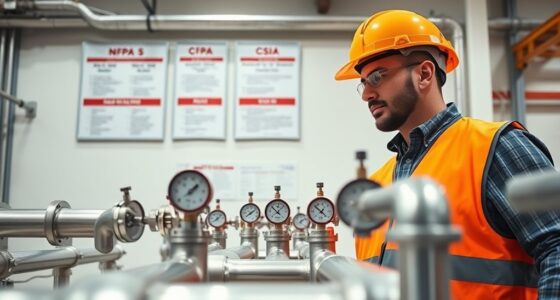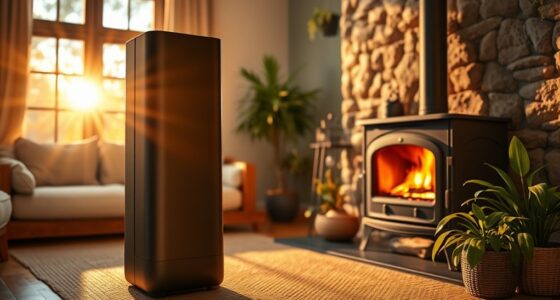To guarantee safety around walls, ceilings, and furniture, you need to maintain proper clearances from heat sources and electrical panels. Keep furniture, curtains, and other combustibles at least 36 inches away from heaters and fireplaces, and follow manufacturer guidelines. Walls and ceilings should also have enough space to prevent heat buildup or fire spread. Staying within recommended clearances reduces fire risks and keeps your home safer—continue to explore more ways to protect your space effectively.
Key Takeaways
- Maintain at least 36 inches of clearance in front of space heaters to prevent heat buildup near combustibles.
- Keep furniture, curtains, and flammable items a safe distance away from heat sources, walls, and ceilings.
- Ensure electrical panels are unobstructed and have proper clearance per manufacturer and code requirements.
- Use fire-resistant materials on walls and ceilings near heat sources to reduce fire risks.
- Install sturdy screens on fireplaces and maintain safe distances from combustible walls and ceiling surfaces.

Maintaining proper clearances to combustibles is essential for preventing fires and ensuring safety around heating equipment, electrical panels, and appliances. When it comes to fire safety, adhering to building codes isn’t just a suggestion — it’s a crucial requirement that helps protect your home and loved ones. Building codes specify minimum distances that must be kept between heat sources and combustible materials like walls, ceilings, furniture, and other household items. Ignoring these guidelines can lead to dangerous situations, including accidental fires that spread rapidly. So, understanding and enforcing these clearances is your first line of defense against fire hazards.
You need to be proactive in ensuring that heating appliances, such as space heaters, furnaces, and stoves, are installed with adequate clearance from any combustible surfaces. For example, many building codes recommend maintaining at least 36 inches of clearance in front of space heaters to allow safe operation and prevent overheating. Similarly, wall-mounted heating units often require a specific distance from the wall to prevent heat buildup and potential ignition. Electrical panels should never be obstructed or placed too close to combustible materials, as overheating or electrical faults can ignite nearby surfaces. Always follow the manufacturer’s instructions and local building codes when installing or repositioning these components.
Furniture placement also plays a vital role in fire safety. Keep sofas, chairs, and curtains away from heat sources, ensuring there’s sufficient space to prevent accidental ignition. Never place flammable items directly on or too close to radiators, baseboard heaters, or other heat-generating appliances. If you have a fireplace, make sure combustible furniture and décor are kept several feet away, and use a sturdy screen to prevent sparks from escaping. Regularly inspecting these clearances is key because furniture can shift or be moved over time, creating new hazards. Additionally, combustible materials can sometimes be overlooked if not properly identified, increasing the risk of fire hazards. Incorporating fire-resistant materials into your home’s design can further enhance safety and reduce risks. It’s also important to consider the influence of building materials on heat interactions, as some materials can either facilitate or hinder fire safety measures. Remember, building codes are designed to promote safe distances, so always check local regulations and update your setup accordingly.
Maintaining these clearances isn’t just about compliance — it’s about your safety. Fire safety depends on thoughtful placement and adherence to established standards. By keeping combustible materials at safe distances from heat sources and electrical equipment, you greatly reduce the risk of accidental fires. Always prioritize safety by following the guidelines laid out in your local building codes and manufacturer recommendations. Doing so not only helps prevent costly damage but also protects lives. When in doubt, consult a professional to ensure your home’s clearances are correct and up to code. Staying vigilant and proactive in managing these clearances keeps your environment safer for everyone. Additionally, incorporating natural materials like wood and stone in your decor can influence how heat interacts with your surroundings, so plan your layout with these factors in mind.
Frequently Asked Questions
How Often Should Clearances Be Inspected or Maintained?
You should inspect clearances to combustibles at least once a year to guarantee safety. Regular inspections help identify any shifts or damage that may reduce clearance distances. Follow maintenance tips like keeping areas clean, checking for obstructions, and ensuring that combustible materials stay away from heat sources. An annual inspection schedule keeps your space safe, and prompt adjustments maintain proper clearances, reducing fire risks and ensuring compliance with safety standards.
Are There Specific Clearance Requirements for Different Types of Furniture?
Did you know that improperly placed furniture causes over 30% of home fires? For fire safety regulations, clearance requirements vary by furniture type; for instance, upholstered sofas need at least 36 inches of space from heat sources. When arranging furniture, always follow specific clearance guidelines to prevent fire hazards. Proper furniture placement is essential for safety, ensuring you reduce risks and maintain compliance with fire safety standards.
Do Clearance Standards Vary Between Residential and Commercial Buildings?
Yes, clearance standards do differ between residential and commercial buildings. Building codes emphasize fire safety differently depending on the type of structure. In commercial spaces, stricter clearances are often required to reduce fire hazards, while residential codes may be more flexible. You should always follow the specific building codes applicable to your building type to ensure proper fire safety and compliance with regulations.
What Are the Penalties for Non-Compliance With Clearance Regulations?
If you don’t comply with clearance regulations, you face liability risks and legal consequences like fines, penalties, or even lawsuits. Authorities can inspect your property, and non-compliance might lead to stop-work orders or required inspections. Failing to meet standards increases fire hazards, risking lives and property. Staying compliant helps you avoid these penalties, protecting you from costly legal issues and ensuring safety for everyone involved.
How Do Clearance Requirements Change With Different Heating Appliance Types?
You need to adjust clearance zone regulations based on your heating appliance type to guarantee safety. For example, space heaters require larger clearances for safety, while fireplaces may have specific clearance guidelines to prevent fire hazards. Always follow manufacturer instructions and local codes, as different appliances demand different clearance requirements to maintain heating appliance safety, prevent overheating, and reduce fire risk. Proper clearances help protect your home and ensure safe operation.
Conclusion
By maintaining proper clearances to combustibles, you protect your home, ensure safety, and prevent fires. You respect the guidelines, follow the standards, and prioritize safety in your space. You check your walls, ceilings, and furniture regularly, adjust clearances when needed, and stay informed about fire safety. Remember, clearances aren’t just rules—they’re your safeguard. By staying proactive, you create a safer environment, reduce risks, and keep your home and loved ones protected every day.











